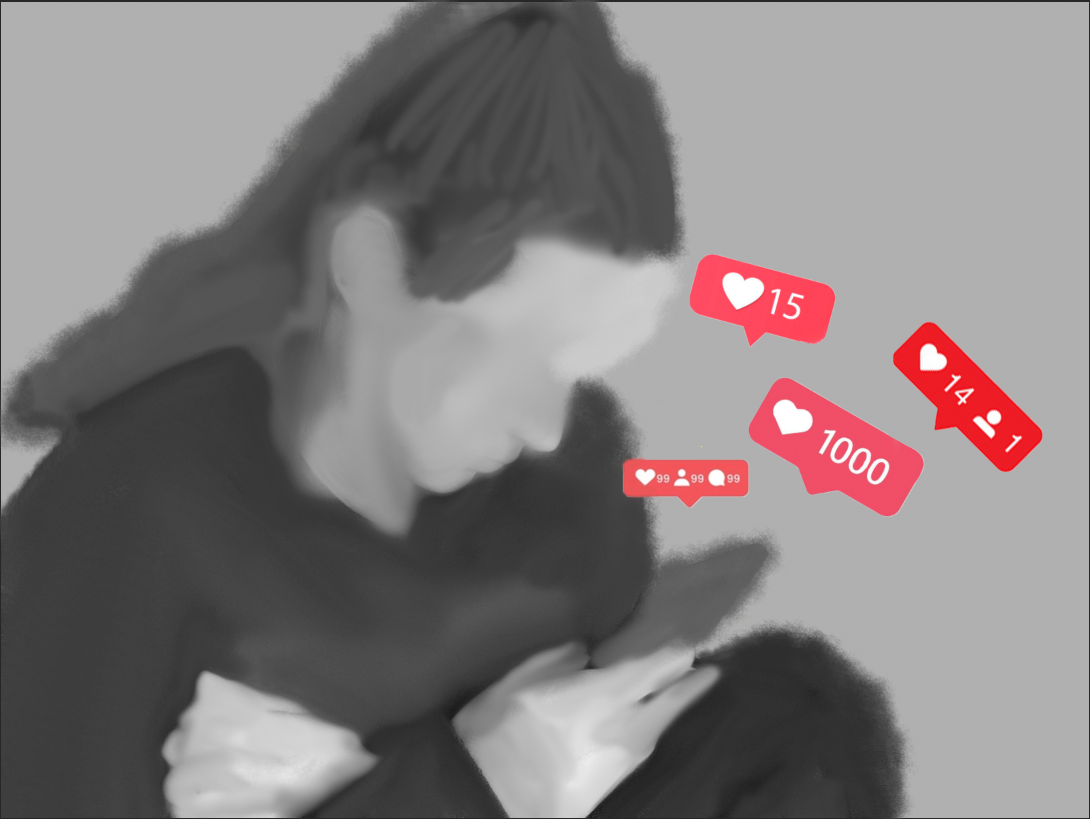Another flaw, another tear, another scar.
Many people have social media, and they spend a lot of their time looking at their friends’ posts and creating their own — but studies show this can lower their self-esteem.
Looking for the perfect angle, perfect background, and perfect lighting to display their features makes every imperfection seem worse.
This effect is most prominently seen in the selfie, which is one of the most common types of posts on social media.
In 2015, a poll conducted by OnePoll showed that the average woman, ages 16 to 25 years old, spends over five hours a week trying to take a good selfie to post on social media.
Even after devoting several hours to finding the best setting, editing is used to make the selfie look perfect. Though it may not seem like a big problem at first, filters, retouching, and makeup added to a picture have a negative effect on a person’s self-esteem.
A poll from the American Academy of Facial Plastic and Reconstructive Surgeons showed that 42 percent of the surgeons in the poll were asked to perform surgery in order to improve selfies and social media posts.
Daniel Holcomb*, a sophomore, said, “I believe that, even with the knowledge that the photos are edited, people will continue to feel like they aren’t good-looking enough to be accepted.”
On Instagram and Snapchat, there are filters that can be used to hide imperfections. And that’s not all; apps such as Facetune can be used specifically to erase pimples or change a person’s facial structure.
Once these pictures are posted, teens who see it are more likely to have self-esteem issues and decreased life satisfaction, according to ScienceDirect.
In her book “Enough As She Is,” Rachel Simmons writes about the pressures that girls face when they compare themselves to others. One girl even told her, “I don’t hate myself when I’m alone, I just hate myself in comparison to other people.”
When girls see these posts with others looking skinny and having no acne, they begin to compare themselves to the girls in the picture. This comparison ends up having a negative effect on them and their self-esteem.
However, it’s not just girls that have to deal with these struggles; boys also have to deal with the pressure of looking strong, brave, and masculine.
“Stereotypically, in order to be a man, you have to do certain things, like not crying, playing football, dating someone hot, or having a six-pack,” said sophomore Alex Nyholm-Goncalves, who is part of the SOS program at Carlmont. “Not only does this lower self-esteem, but social media also tells boys they can’t speak up because they have to be strong. Saying that means that they can’t say how hurt they are which leads to self-harm and eventually suicide.”
Pictures that have no imperfections further the perception that each gender has certain stereotypes they have to live up to. When these stereotypes are not met, teens believe that they are flawed and imperfect; this belief only worsens if that particular photo has a lot of likes and if that account has a lot of followers.
However, it’s not just selfies and stereotypes that lower self-confidence.
On Instagram and Tumblr, there are several accounts dedicated to telling stories about suicide, depression, and self-harm.
“Depression, suicide, and self-harm are shown a lot because people are trying to make it known that it’s a big deal,” said Payton Vogt, a junior that is also part of SOS. “And it’s a big problem, but there’s a certain point where if you show too much of it, people will find it hard to see and listen to it since it’s everywhere.”
Despite the fact that the owners are sharing their stories, the posts desensitize depression and suicide as they begin to appear more frequently.
When depression appears as often as it does, it becomes less of a problem as its rarity dies down.
On Instagram, there are as many as 7.9 million posts with the hashtag “suicide” and 16.9 million posts tagged “depression.”
A lot of the posts talk about how hard living with depression is, while others give first-aid tips to help those who self-harm.
“Teaching healthy coping skills is a huge piece of what SOS does,” said SOS founder and school crisis counselor Shelley Bustamante. “Cutting is a coping skill but it’s not healthy. You can cut too deep, which can leave scars. As a result, you can feel worse about yourself after doing it and you’re reminded about it when you look at it, so teaching someone to use things like breathing techniques and journaling as coping skills instead of self-harm is important.”
There are also posts that rank certain circumstances of depression as worse than others. However, depression is not a mental illness that can be ranked since it varies from person to person.
“Everybody’s perception of their own experience and how they interpret that is different,” said school counselor Kim Miller. “You can’t rate one form of depression as worse than another.”
Sometimes, people who do not have depression attempt to label the severity of somebody else’s depression on social media.
“In general, a lot of people say that depression is not that bad,” Nyholm-Goncalves said. “But they don’t know what it’s like. It’s so much more difficult than just putting on a happy face. When someone posts ‘oh it’s not so bad just get over it,’ it’s the worst thing.”
If teens continue to see posts that tell them what they are going through could be worse, they will bottle up their emotions until they burst.
“No matter how little the problem is, it’s still a problem,” Nyholm-Goncalves said. “It’s still something others can help you fix. No matter what your problem with life is, if you’re comfortable enough, you should still talk about it or have someone there to help you.”
*This source wished to remain anonymous


